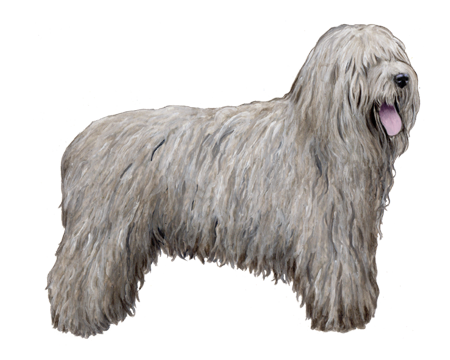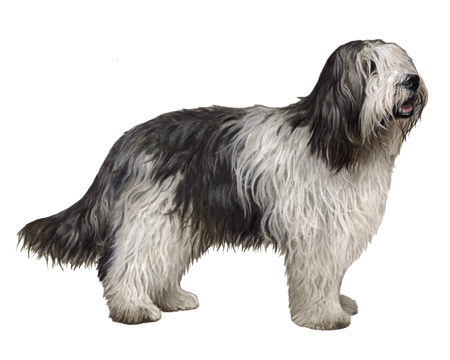
Shetland Sheepdog
The Shetland Sheepdog is a small, alert, working dog. Though it bears a striking resemblance to the rough-coated Collie, this is a breed all its own, prized for its intelligent, obedient, and affectionate nature.
Interested in discovering if your dog is a Shetland Sheepdog?
Check out Wisdom Panel's DNA tests.

Shetland Sheepdog Traits
General Appearance
Shetland Sheepdogs are small, longhaired dogs that move with effortless speed and a trotting gait and appear to have alert, gentle, intelligent expressions.
Coat and Colouring
Shetland Sheepdogs have double coats: their short undercoats are so dense that it causes the outer coat to “stand off” of their bodies; the outer coat is long, straight hair with a harsh texture. A smooth coat is considered a serious fault.
Shetland Sheepdogs have smooth hair on their faces, tips of their ears, and feet, and abundant hair on their mane and frill, which are more pronounced in males. The breed standard allows excess hair on ears, feet, and on hocks to be trimmed for the show ring.
The breed comes in three colors: black, blue merle, and sable (with colors ranging from light golden through mahogany) and marked with varying white or tan.
Distinctive Physical Traits
These are small dogs with muscular backs, deep chests, and broad, strong thighs. Their tails are long and carried straight down or in a slight upward curve at rest.
Shelties have well-rounded muzzles; small ears set high and carried three-quarters erect; and almond-shaped dark eyes (with blue or merle eyes allowed in dogs with blue merle coloring).
Shetland Sheepdog Temperament
Shetland Sheepdogs are loyal, affectionate family pets. Shelties will adapt to life in the city as long as they get regular exercise. Their herding instincts could lead Shetland Sheepdogs to chase moving cars or other animals, so a fenced yard is a good idea.
Their tendency to bark may not endear Shetland Sheepdogs to the neighbors, but the breed does make an excellent watchdog.


Shetland Sheepdog History
Shetland Sheepdogs hail from the remote Shetland Islands in Scotland. The breed traces its origins to the Border Collie, which breeders then crossed with smaller longhaired breeds to create a small dog to herd sheep, ponies, and chickens.
Shetland Sheepdogs worked on local farms, called “toons,” leading to the slang nickname Toonie Dog. Their small size proved to be a significant benefit: The diminutive dogs ate less than larger breeds, an essential trait on a remote island where food was scarce.
Their geographic isolation meant that Shetland Sheepdogs, also known as Shelties, lived in isolation.
Shelties remained virtually unknown outside of the Shetland Islands until the early 1900s. Recognized as the Shetland Collie when the breed gained admission to the Kennel Club in England in 1909, the breed soon became named the Shetland Sheepdog.
Shetland Sheepdog Care
Nutrition
Feed Shetland Sheepdogs a high-quality dog food appropriate for their life stage (puppy, adult, senior). Portion out their food with a measuring cup and limit treats to no more than 10 percent of their daily calories to prevent overfeeding.
Grooming
Shetland Sheepdogs need regular attention to keep their hair free of mats, tangles, and debris. Weekly brushing with a pin brush will remove dead undercoat and keep their coats looking sleek. Pay special attention to the areas around the ears, under the elbows on each front leg, and the “pants” under the tail, which are more prone to matting.
Shetland Sheepdogs require almost-daily grooming during shedding season to remove dead hair and keep up with excess shedding. Their coats protect against the elements, so shaving their coats is not recommended.
Shetland Sheepdogs benefit from a regular dental care routine that includes at-home teeth brushing and professional cleanings. Start these grooming practices when Shetland Sheepdogs are puppies to ensure they become a habit.
Exercise
Like other herding breeds, Shetland Sheepdogs require moderate amounts of exercise to be happy and healthy.
In addition to walks, hikes, and trips to the dog park, Shetland Sheepdogs also enjoy dog sports such as obedience competitions, agility, tracking, herding, and other activities that allow the breed to show off speed and stamina and spend time with their owners.
Mental stimulation is important, too. Provide puzzle toys or engage Shetland Sheepdogs in games like fetch or hide and seek to engage their minds and their bodies.
Training
Shelties are intelligent, eager to please, and trainable. With positive reinforcement and rewards, Shetland Sheepdogs can master basic commands and learn new tricks. Consistent training can also help teach these vocal dogs to stop barking.
Early socialization can help make Shetland Sheepdogs feel more comfortable with strangers.

Shetland Sheepdog Genetic Health Conditions
-
MDR1 Medication Sensitivity
The MDR1 gene variant causes a defect to a drug pumping protein that plays an important role in limiting drug absorption and distribution (particularly to the brain). Dogs with the MDR1 variant may have severe adverse reactions to some commonly used medications.
-
Progressive Retinal Atrophy (Discovered in the Shetland Sheepdog - BBS2 variant)
Progressive Retinal Atrophy (PRA) is an eye disease resulting in gradual loss of vision. Dogs with this form of the disease can show additional features including a wavy, atypical coat texture, an upturned nose and dental defects.
-
Progressive Retinal Atrophy (Discovered in the Shetland Sheepdog - CNGA1 variant)
Progressive Retinal Atrophy (PRA) is a disorder that causes the degeneration of the light sensing retina at the back of the eye, resulting in vision loss and eventual blindness.
-
von Willebrand's Disease, type 3 (Discovered in the Shetland Sheepdog)
von Willebrand's Disease (vWD) Type 3 is a clotting disorder that causes severe bleeding tendencies in affected dogs.
Knowing if your Shetland Sheepdog is a carrier or at-risk for these conditions can help you and your veterinarian plan for your pup's lifelong care. With Wisdom Panel™ Premium, you can get results for over 200 genetic health tests.
Breed Group
Herding
The herding group is a diverse category. These highly intelligent breeds were developed to guard and control the movement of livestock.
Resources
https://www.akc.org/dog-breeds/shetland-sheepdog/
http://images.akc.org/pdf/breeds/standards/ShetlandSheepdog.pdf
Reviewed 26 July 2020 by Laura Inman, DVM

































































